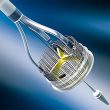A recent presentation at London Valves took a closer look at the REPRISE III trial as regards two points that generated much discussion, such as need for a pacemaker and paravalvular leak. REPRISE III had previously demonstrated that the Lotus is noninferior to first-generation CoreValve and Evolut R in terms of safety. Additionally, it proved to be superior...
Transcatheter Reduction or Surgery for Paravalvular Leak Repair?
Paravalvular leak is complication derived from incomplete sealing between the implanted prosthesis and the native annulus, which occurs in 5% of all patients who undergo mitral valve replacement and 10% of those who undergo transcatheter aortic valve replacement. This is the most frequent non-structural valve dysfunction. While mild leaks can be asymptomatic, moderate to severe...
Percutaneous Repair of Paravalvular Leaks After TAVR: The Challenge of Identifying Eligible Subjects
Courtesy of Dr. Carlos Fava. This study enrolled 72 patients who underwent transcatheter aortic valve replacement with an Edwards Sapiens valve, and then experienced a leak of at least moderate severity. Fifteen of them underwent a percutaneous leak repair after identification of the leak mostly through the presence of symptoms. Both groups were similar. Patients who...
Paravalvular Leak in Surgical Prosthesis: How to Treat Them
Courtesy of Dr. Carlos Fava. The presence of paravalvular leaks (PVL) after aortic valve replacement ranges between 5% and 20%. Percutaneous repair has emerged as a feasible alternative, effective and safe, to prevent new surgery. The study included 86 patients undergoing aortic valve replacement presenting PVL with cardiac failure CFIII or IV and/or anemia....
Endovascular treatment of Mitral Paravalvular Leaks
Saibal Kar2014-10-30 MD, FACC, FAHA, FSCAIHeart Institute, Cedars Sinai Medical Center, Los Angeles, CA
Cierre Percutáneo de Leaks Paravalvular Mitral en Paciente de Alto Riesgo Quirúrgico
Gustavo Pedernera2014-12-06 Servicio de Cardiología Intervencionista y Terapias EndovascularesInstituto Cardiovascular de Buenos AiresBuenos Aires, Argentina
Prosthesis-Annular Size Ratio and Its Impact on Leaks
In low-risk patients, there was a very low incidence of greater than moderate leak, including in patients with minimal oversizing. The degree of prosthesis oversizing had a great impact on mild paravalvular leak reduction and the need for post-dilation without changing valve hemodynamics. This research investigated the impact of the perimeter and the area, measured...
SAPIEN 3 Ultra: Lower Incidence of Paravalvular Regurgitation?
Paravalvular regurgitation after transcatheter aortic valve replacement (TAVR) have historically been associated with worse clinical outcomes. Even mild leaks have been shown to be harmful. This study looked at a real-world experience with the transcatheter heart valve SAPIEN 3 Ultra in the US. The SAPIEN 3 Ultra is a new generation balloon-expandable heart valve with...
Surgical or Percutaneous Management of Mitral Leak
Mitral paravalvular leaks are relatively common after surgical mitral replacement, with an incidence of 7%-17%. Most of these are subclinical leaks, a mere echocardiogram finding, but about 3% of patients can develop heart failure, hemolysis, or a combination of both, thus requiring a new intervention. For symptomatic patients, new surgery has been the traditional treatment...
Mild Leaks: TAVR’s Silent Enemies
Courtesy of Dr. Carlos Fava. Even though the presence of paravalvular regurgitation (PVR) has been reduced, thank to greater experience and new devices, it is still frequent and has an impact in survival (especially moderate and severe PVR). Recent research has shown that mild PVR also has a negative impact. However, these data were provided...








